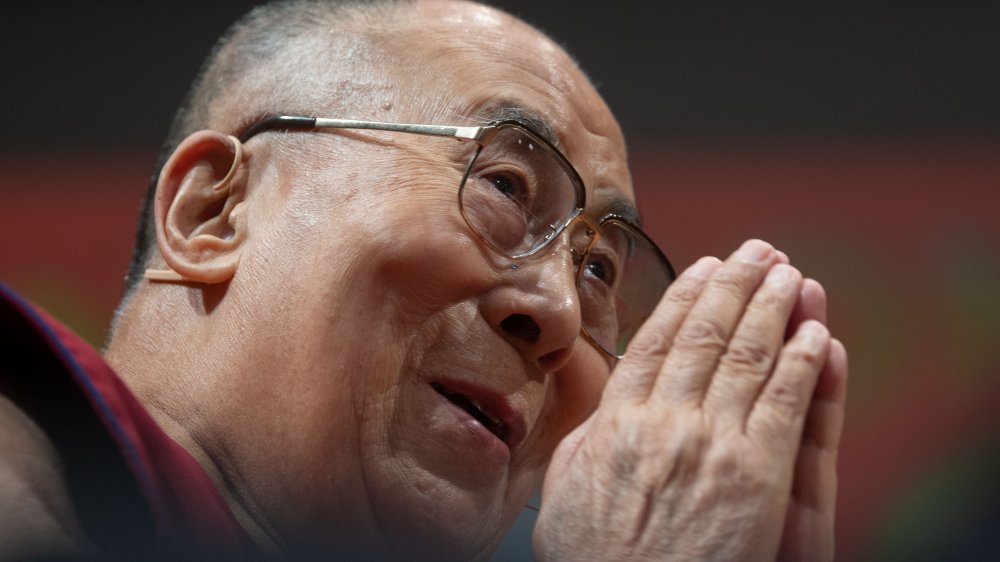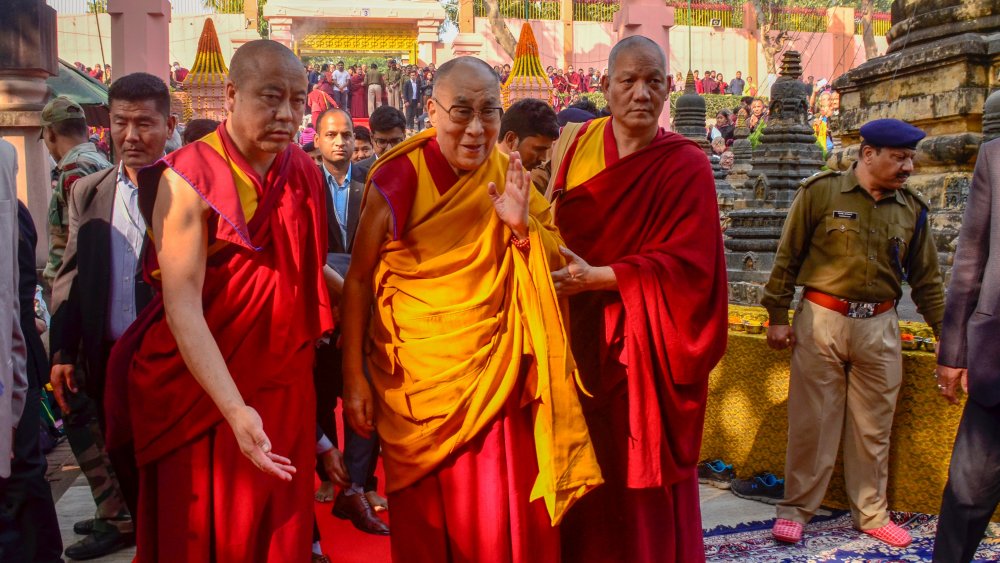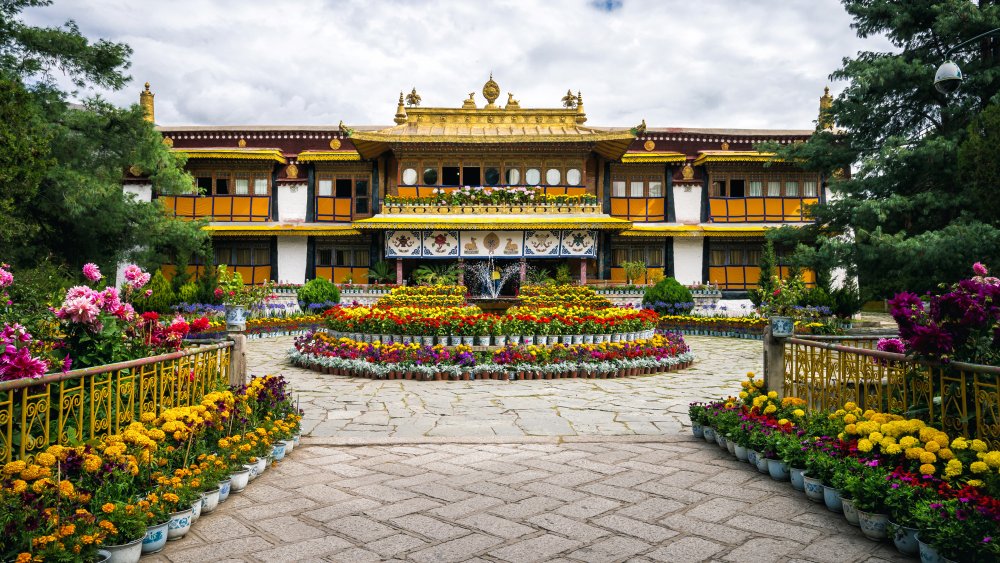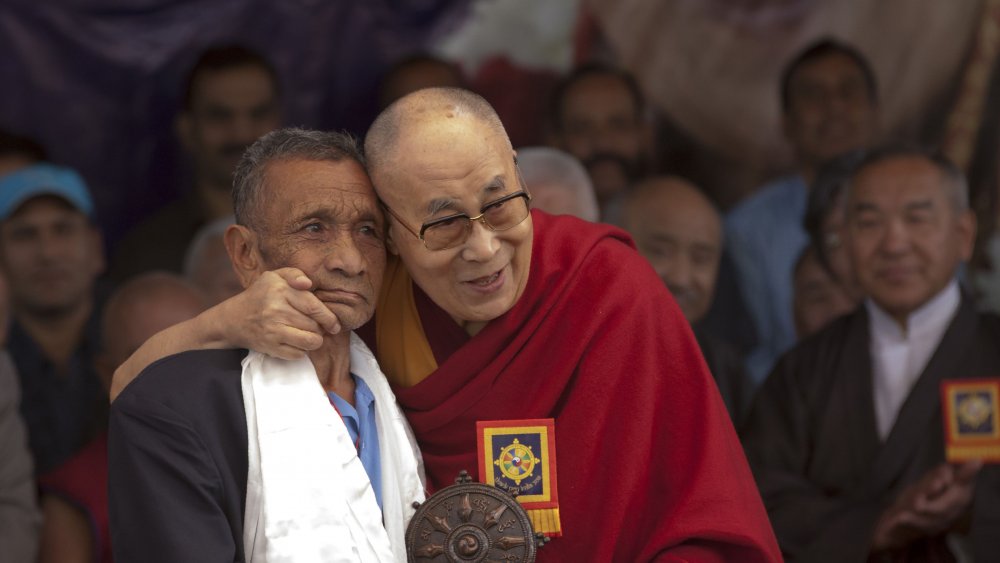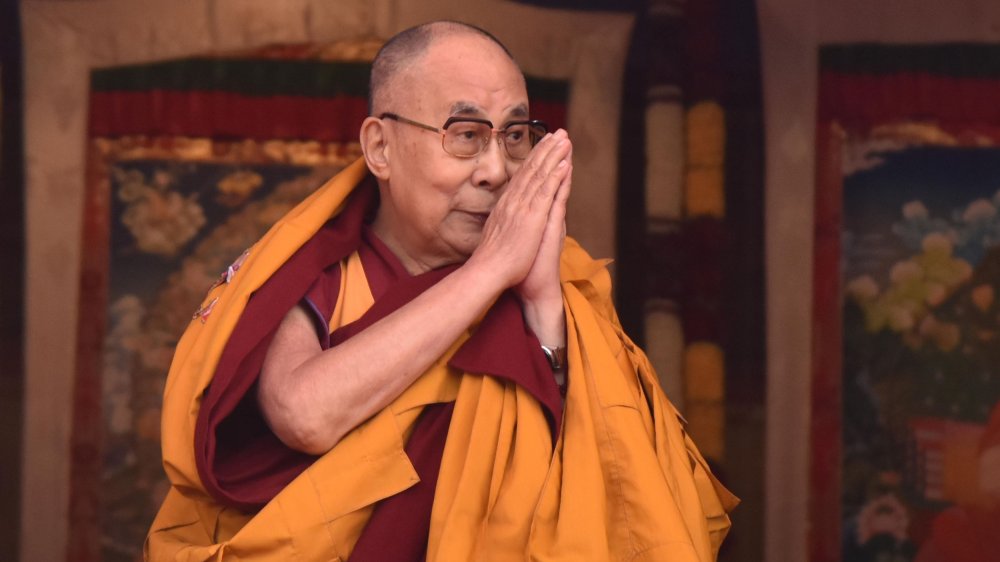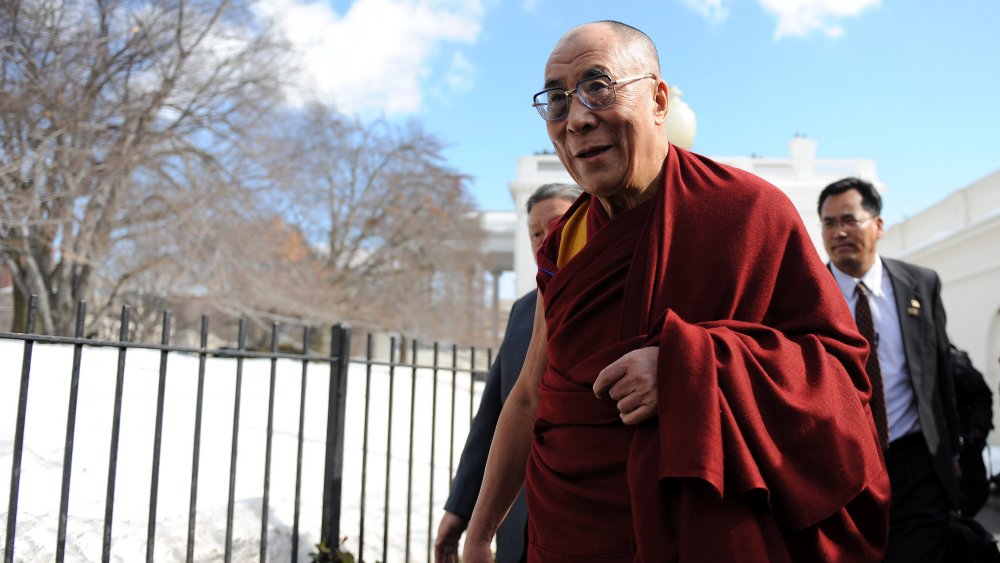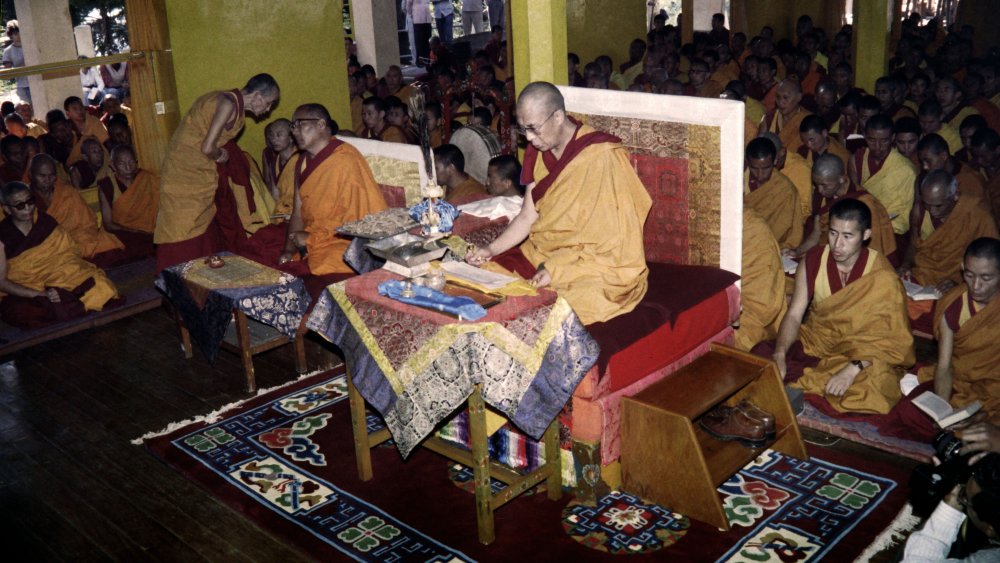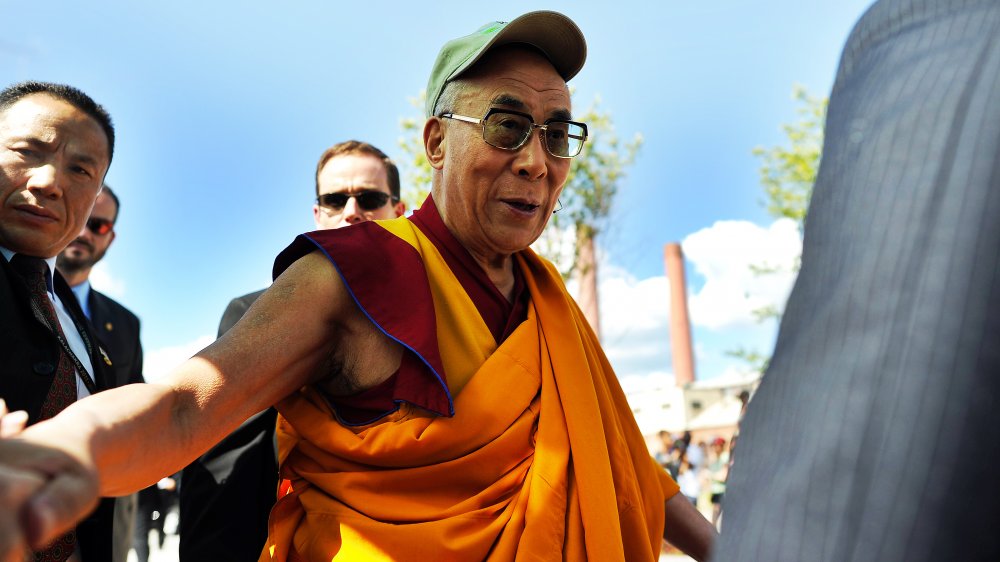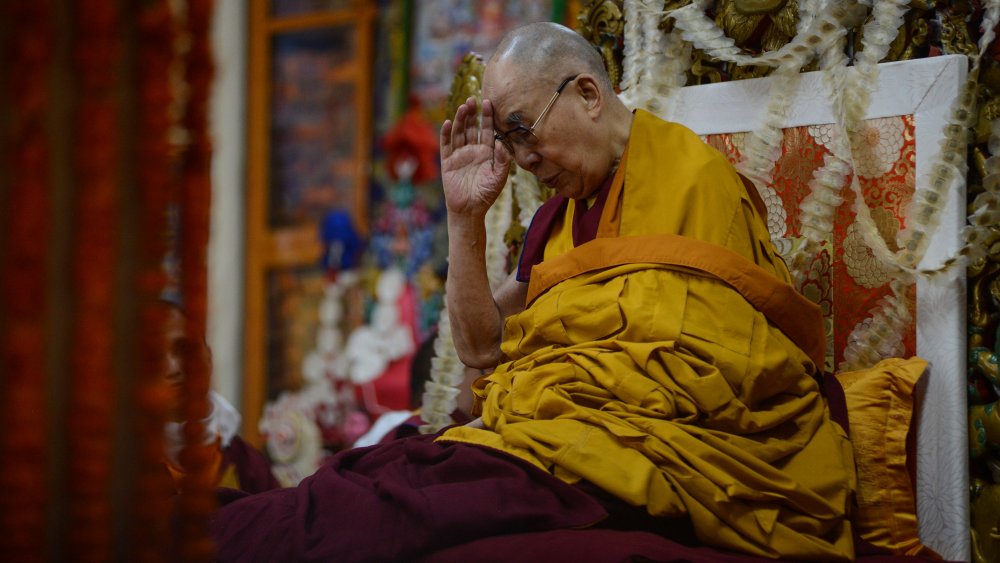The Tragic Real-Life Story Of The Dalai Lama
His proper title is His Holiness the 14th Dalai Lama, Tenzin Gyatso, and he's one in a long line. According to the official history, this office at the head of Tibetan Buddhism goes back to the 15th century and The First Dalai Lama, Gedun Drupa. He was known for spreading Buddhist teachings across Tibet, but teaching is just one small part of what it means to be a Dalai Lama.
Traditional beliefs say every Dalai Lama is a manifestation of Avalokiteshvara, a figure introduced to Tibetan Buddhism in the 7th century. He's a bodhisattva (which means he's someone who is on the path to awakening, and to eventually becoming a buddha), and he's a figure who personifies a particular mindset: the desire to postpone his own rise to becoming a buddha until each and every being on earth has been liberated from pain, suffering, death, and rebirth.
And so, the Dalai Lama has been reborn again and again, in order to keep returning to a place where he can help all living beings. And even though he has renounced Nirvana in order to help end the suffering of souls across the world... well, the world hasn't been the kindest to this Dalai Lama.
Who and what, exactly, is the Dalai Lama?
While the Dalai Lama is definitely a major religious figure, he's also much more than that. According to Time, the Dalai Lama has traditionally held supreme political power, too — at least, he has since the 17th century. That's when a major shift happened: not only was he at the head of Tibetan Buddhism, but he had "full political authority" over Tibet. That included the 14th Dalai Lama as well... at least, until March 17, 1959. And then again in 2011.
The story of the Dalai Lama is the story of Tibet, and there's a few things that warrant a little up-front explanation. When the Dalai Lama was exiled to India, he set up the Central Tibetan Administration, which is essentially a government-in-exile. The Dalai Lama was always at the head of it, until he retired from politics.
That happened in 2011 (via The Guardian), as he announced, "As early as the 1960s, I have repeatedly stressed that Tibetans need a leader, elected freely by the Tibetan people, to whom I can devolve power. Now, we have clearly reached the time to put this into effect." That same year, the BBC reported that Lobsang Sangay had been elected to replace the Dalai Lama who — for the first time — was taking a step closer to his lifelong, but always elusive, desire: to simply live as a monk.
Born into simplicity, elevated to greatness... as a toddler
The 13th Dalai Lama died in 1933, and according to Time, it took four years before his successor was found. Search parties were guided by visions and dreams, and it was the 13th who told them where to look: the official history says that as he was being mummified, his head turned to look northeast.
There was the small village of Taktser, and it was home to little Lhamo Thondup and his family. They were poor farmers, and Lhamo was one of 16 children, although only seven survived childhood. His memories, he says, "were very ordinary," but distinct. One of his favorite things to do was to pack his things and declare he was going to Tibet's capital, Lhasa, and when he was born, his father had somewhat miraculously recovered from a severe illness.
He was only 2-years-old when representatives of the Tibetan government discovered him. Any doubts he was the reincarnation of the 13th Dalai Lama disappeared when he recognized and named the men who came to his house, and correctly picked items — teacups, drums, rosaries, and a walking stick — that had belonged to the previous Dalai Lama. From there, he was taken from his home and ultimately, to Lhasa — as he had predicted. It wasn't an easy transition for the toddler, and he would later write, "There now began a somewhat unhappy period of my life."
The Dalai Lama was bearing the weight of the world as a teenager
On February 22, 1940, little Lhamo Thondup was officially installed as spiritual leader of the Tibetan people. He was just 5-years-old.
The following years were spent studying subjects like logic, Sanskrit, and medicine, along with Buddhist philosophy. Ten years passed, and everything changed on one day in 1950. News of a raiding party of Chinese soldiers arrived and suddenly, the threat of invasion was very real. Tibet needed their leader, so at just 15-years-old, the Dalai Lama was given full political authority and was enthroned as the head of around six million people... people who knew that war was on their doorstep. Things got off to a rocky start: he dispatched delegations to Britain, the US, and Nepal, appealing for help against China. They were all turned away, and the teenage ruler was faced with a terrifying future: "I remember feeling great sorrow when I realized what this really meant: Tibet must face the entire might of Communist China alone."
Talks with China went no better. According to the Dalai Lama's official history, he only heard it on the radio that the delegation he sent to China had agreed to the 17-Point Agreement, which the International Campaign for Tibet says was the document that changed Tibet from a free country to an area of China. The young Dalai Lama had been sitting, alone, when he heard his country had fallen.
The 1959 uprising
During the first years of Chinese occupation, the Dalai Lama saw things getting harder and harder for his people. Crops grown by Tibetan farmers were sent to China, while those in Tibet starved. Weapons and land were taken away, and China began to accuse Tibetan monks and nuns of secretly acting on behalf of resistance groups (via ThoughtCo.)
Then, something incredibly suspicious happened. Representatives of the Chinese Army invited the Dalai Lama to a theatrical performance and a tea at their Lhasa headquarters. Invitations turned to demands, and they agreed on March 10,1959. But when they followed the request with instructions that he should come alone, that didn't sit well with anyone — especially when word leaked to the public. Fears that the Dalai Lama would be taken were very real, and Free Tibet says that's when tens of thousands of people gathered around the Dalai Lama's Norbulingka Palace to make their fears known. He didn't go.
It was just the start. More people assembled and, according to History, fighting started two days later. Then, on March 21, the Chinese Army started shelling the palace and the protesters, killing thousands of men, women, and children. The Dalai Lama's guards were executed, monasteries around Lhasa were also attacked and destroyed, and by then, the Dalai Lama was already gone. On March 17, he snuck out of the palace and started his long trek to India. When the next census was taken, the Tibetan population had dropped by 300,000.
The Dalai Lama's trek across the Himalaya
It was late on March 17 that the Dalai Lama disguised himself as a soldier and walked out of his home for the last time, passing unseen through the crowds that gathered, fearing for his safety. Along with about 20 other people, he traveled only by night, took temporary refuge in tiny villages along the way, and prayed the planes flying overhead wouldn't see them.
Free Tibet says that by the time they reached the border, Chinese troops had been drawing close to his caravan. But when he reached Lhuntse Dzong, he sent a message to then-Indian Prime Minister Jawaharlal Nehru, asking for asylum. It was given: they were met by Indian forces and escorted the rest of the way to safety. Word of his appearance in India shocked the world — according to The Guardian, many feared he had been killed in the uprising. Around 80,000 Tibetans followed him into exile, and they set up a government-in-exile in Dharamsala. He'd fled his home, and would never return.
And he never forgot the kindness and welcome India showed him. He's referred to himself as the "longest guest of the Indian government," and in 2017, he once again met Naren Chandra Das (pictured), one of the guards who escorted him to safety. Giving the soldier a hug, the Dalai Lama said he was happy to see him, and added, "Looking at your face, I now realize I must be very old, too."
The disappearance of the Panchen Lama
The Dalai Lama hasn't just been at the center of tragic events, uprisings, and death, he's seen those around him suffer, too. Second to the Dalai Lama is the Panchen Lama, and they go hand-in-hand. At the death of the Dalai Lama, it's the Panchen Lama who plays the biggest part in recognizing his reincarnated self. Then, at the death of the Panchen Lama, it's the Dalai Lama who recognizes his reincarnated self.
The Panchen Lama who recognized the 14th Dalai Lama was outspoken against Chinese rule... and he died in 1989, under what Free Tibet calls "suspicious circumstances." Then, on May 15, 1995, the Dalai Lama announced that he had found the next Panchan Lama. His name was Gedhun Choekyi Nyima, and he was 6-years-old. Two days after the announcement, the boy and his family disappeared. They're still missing.
Meanwhile, the Chinese government appointed their own Panchen Lama, who Tibetans call "Panchen Zuma," or the "false Lama." At the same time, they've told various stories about what happened to Gedhun — they've said he was held in Beijing under "protection," that he went home to his birthplace, or that he was in the Gansu Province. In spite of repeated requests from the United Nations, it's still unknown what happened to the boy officially recognized by the Dalai Lama.
The Dalai Lama watched from a distance as his people were arrested
In 2013, Reuters reported on a small reversal by the Chinese government: they had lifted a 17-year-long ban on the display of the Dalai Lama's picture, but only at the Gaden monastery in Lhasa. Elsewhere, displaying his picture could still land Tibetans in trouble. In 2016, shopkeepers in eastern Tibet were issued this warning (via Free Tibet): "If any shop or store has possessed photos and portraits of the Dalai Lama and displayed those before the date of this notice, they should be voluntarily surrendered to the Drango county Office of Culture and Discipline by 2nd February 2016." They were warned that those who didn't comply would face "severe punishment," and that's happened.
In 2018, the Tibetan Journal reported that two Tibetan businessmen were arrested because they had photos of the Dalai Lama, and it's not just possessing physical photos that can get someone in trouble — in 2009, Reporters Without Borders announced two Tibetans had been given 3-year jail sentences for posting photos of the Dalai Lama online.
The Dalai Lama's teachings are equally forbidden. In 2020, Free Tibet reported on the arrest of a 75-year-old man and his son. The pair were from the Tibet Autonomous Region, and were detained on "suspicion of loyalty to the Dalai Lama and listening to one of his teachings..." They were released after signing an affidavit that they would no longer listen to his words.
The Dalai Lama is put in a precarious position by people who die for him
It's impossible to stress how dire the situation in Tibet is for some of those who live there, and some have gone to extreme measures to protest their occupation by China and demonstrate their loyalty to the exiled Dalai Lama. According to the International Campaign for Tibet, 156 people have self-immolated in the decade between 2009 and 2019.
According to the Brown Political Review, videos of people self-immolating have included pleas to the Dalai Lama. When a Tibetan man set himself on fire on December 23, 2017, someone yells, "Gyalwa Tenzin Gyatso [the Dalai Lama], grace us with your compassionate gaze."
And that's put the Dalai Lama in an incredibly uncomfortable position. He's regularly advocated for nonviolent solutions to problems, and he was even awarded the Nobel Peace Prize in 1989 for his stance of non-violent resistance to Chinese occupation in Tibet. But when it comes to self-immolation, it's not clear-cut. He's managed to dissuade some of them, but he's declined to come out and say directly that he's against them. Why? As he told John Oliver in 2017, he can't condemn the actions of those who do it because then "their family... feels very sad [that] one of their family members did something against the Dalai Lama's wish."
The Dalai Lama is often shunned on the global stage
When US President Barack Obama was scheduled to meet with the Dalai Lama in 2010, it was far from a normal, diplomatic meet-and-greet. According to The Guardian, it came with a warning from China: the meeting could "cause further damage to Sino-US relations." But by June 2016, Reuters was reporting on Obama's fourth White House meeting with the Dalai Lama, and said the president had "warm personal feelings" for the exiled leader.
Not everyone has been so kind. In 2016, The New York Times reported that Mongolia — who had once helped establish the office of Dalai Lama centuries before — publicly apologized for letting him visit. The apology came after China objected to the meeting and canceled their own appointments with Mongolian officials.
Then, in 2017, the Global Times reported that his trip to Botswana had been cut short: while the Dalai Lama cited health concerns, experts at the China Tibetology Research Center suspected it had something to do with China's warnings that associating with the Dalai Lama would have consequences. Zhang Yijiong, head of the Communist Party's Tibet working group, had this to say in 2017 (via Reuters): "Although some people say, the Dalai is a religious figure [...] this is incorrect. Officials [...] represent their governments. So I hope governments around the world speak and act with caution and give full consideration their friendship with China and their respect for China's sovereignty."
The Dalai Lama remains hopeful for a return to Tibet, but...
The Dalai Lama has been open about what he would like to see for Tibet, and it's not what most might expect. Instead of complete independence, he's spoken about his desire to see a Tibet that "remains within the People's Republic of China enjoying a high degree of self-rule or autonomy." And that would mean working with China to develop the country, but to preserve their culture and spiritual beliefs. Will it happen, and will there be a day when the 14th Dalai Lama can return to the homeland he fled in 1959?
He hopes so. "Yes," he says on his official Q&A. "I remain optimistic that I will be able to return to Tibet."
But, he's also realistic. According to the Los Angeles Times, he's also been vocal about his belief that if Tibet hasn't been given their autonomy, that he wouldn't even return there in his next reincarnation. And he's taken precautions in case that does, indeed happen — he's transferred his political power into the hands of another. Just in case.
The Dalai Lama has been candid about what comes next for him
With this Dalai Lama's death will come a major time of uncertainty: will Tibet's Buddhist community choose his successor, or will China? According to NPR, previous Dalai Lamas have given hints as to where they're going to be reincarnated. But now, for the first time, it's about more than spirituality — it's about control. Tibet and China might not agree... so what does the 14th Dalai Lama think?
He's dropped a series of hints, suggesting that first, he'll live to be 113. He's also said that he'll return to a free country, maybe into the body of an adult or a woman, and possibly, he'll return to several bodies at the same time. But he also says that he and he alone will decide, and nothing China has to say about it should be trusted.
He's also said (via the Los Angeles Times) that he sees a possible future where he doesn't choose to reincarnate at all. There's a few reasons for it: a weak Dalai Lama would weaken the position of Tibet, and they run the risk of political entities "misusing the reincarnation system to fulfill their own political agenda." This is nothing new — as far back as 1969, the Dalai Lama has made it clear that he believes it's time for the people of Tibet to choose their own religious leaders — democratically, through elections.
China's attempts to erase the Dalai Lama
In 2018, The Diplomat reported on China's plans for Buddhism: they were going to kick off a series of "bureaucratic reforms" intended to reinforce the position and power of the Chinese Communist Party (CCP). First and foremost was the "sinicization" of religions in China, with the goal of bringing the objectives of major religions in line with the goals of the CCP. Even though Time says the CCP is officially atheist, they also say Buddhism is one of their first targets. When their rebranding of Buddhism (which, History says, originated in India with Siddhartha Gautama, the original, 5th century BC Buddha) was complete, they'd turn it into an ancient Chinese religion.
And Time also suggests that a lot of this rebranding is being done to help erase the importance of the Dalai Lama. The CCP regularly refers to him as a "wolf in monk's robes," and a major threat. Their appointment of their own Panchen Lama in lieu of the one chosen by the Dalai Lama suggests they've long been preparing to make their own choice for 15th Dalai Lama, a move that will "be a symbolic final nail in the coffin of Tibetan self-rule, completing the absorption of Tibet into the People's Republic of China."
The very thing the 14th Dalai Lama has struggled against for decades.
